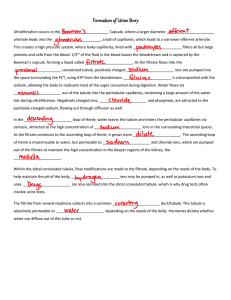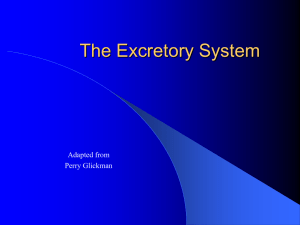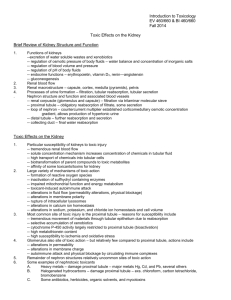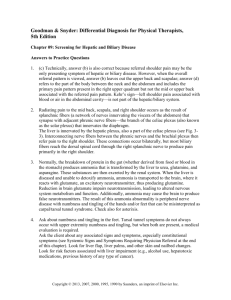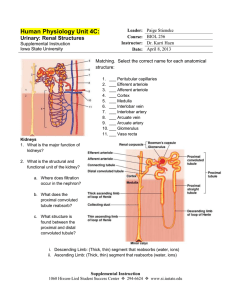Lisa C. Theis for the degree of Master of Science
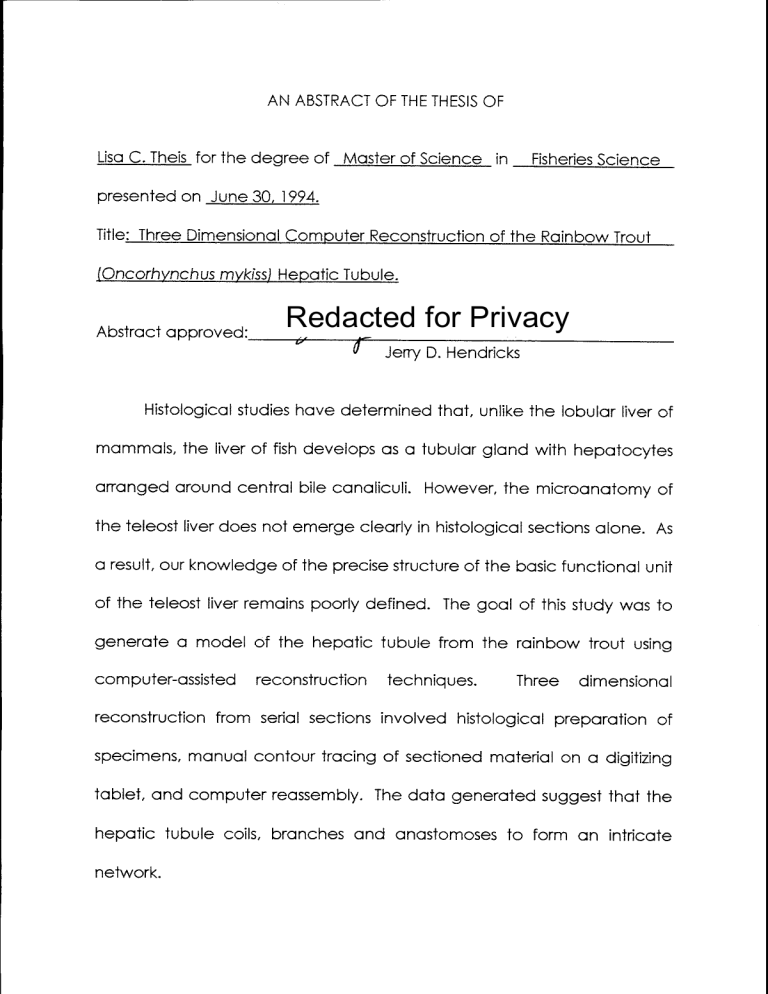
AN ABSTRACT OF THE THESIS OF
Lisa C. Theis for the degree of Master of Science in Fisheries Science presented on June 30, 1994.
Title: Three Dimensional Computer Reconstruction of the Rainbow Trout
(Oncorhynchus mykiss) Hepatic Tubule.
Abstract approved:
Redacted for Privacy
JerrN.
/ D. Hendricks
Histological studies have determined that, unlike the lobular liver of mammals, the liver of fish develops as a tubular gland with hepatocytes arranged around central bile canaliculi. However, the microanatomy of the teleost liver does not emerge clearly in histological sections alone. As a result, our knowledge of the precise structure of the basic functional unit of the teleost liver remains poorly defined. The goal of this study was to generate a model of the hepatic tubule from the rainbow trout using computer-assisted reconstruction techniques.
Three dimensional reconstruction from serial sections involved histological preparation of specimens, manual contour tracing of sectioned material on a digitizing tablet, and computer reassembly. The data generated suggest that the hepatic tubule coils, branches and anastomoses to form an intricate network.
The primary motive for defining the precise structure of the trout hepatic tubule was to assist studies attempting to determine the existence of a stem cell in fish liver. Currently the biliary preductule cell is the putative stem cell found in fish liver. These cells are located within the
center of the hepatic tubule and are visible as irregular, elongate,
basophilic nuclei.
In
this study biliary preductule cells occurred at
apparently random intervals along the length of each tubule.
Three Dimensional Computer Reconstruction of the
Rainbow Trout (Oncorhynchus mykiss) Hepatic Tubule by
Lisa C. Theis
A THESIS submitted to
Oregon State University in partial fulfillment of the requirements for the degree of
Master of Science
Completed June 30, 1994
Commencement June 1995
APPROVED:
Redacted for Privacy
Professor of od Science and Technology in charge of major
Redacted for Privacy
Head of department of Fisheries and Wildlife
Redacted for Privacy
Dean of Graduat hool
Date thesis is presented
Typed by researcher for
June 30, 1994
Lisa C. Theis
ACKNOWLEDGMENTS
I would like to thank my major professor, Jerry D. Hendricks, for his advice and guidance throughout the course of this study. His resourceful experience gave direction to the project.
I am greatly indebted to Dan Arbogast for the enthusiastic interest
he took in
this project from beginning to end.
I
welcomed any
suggestions and ideas he offered but more importantly, I appreciated his friendship.
Moreover, he was instrumental in acquiring, assembling and maintaining the computer used in the reconstruction process.
I value his insight and problem solving skills and am grateful for his contributions.
Special recognition is given to Ulrich Harttig whose experience with the software, Autodesk 3D Studio, enabled me to complete my project in a timely fashion. His willingness to loft and render the final models proved invaluable. He was a true asset and his competence is evident in the final animations.
I appreciate the generosity of Kevin Currans who provided the computer hardware as well as the 3-D software package. This equipment was essential for the successful completion of my thesis.
Corwin Willard was especially helpful in teaching me how to use the image analysis system. He showed much patience with my then limited
knowledge of computers. His willingness to walk me through the steps necessary to capture and print quality images is greatly appreciated.
I am grateful to Mike Burner who always had complete confidence in my abilities.
He assisted me in the laboratory during the perfusion
process where it seemed there were never enough hands holding,
cutting or pouring.
I greatly appreciate his patience. He is my closest confidant and counselor.
In closing I would like to share a quote I encountered while visiting the Bronx Zoo. It always rings in my mind and seems a fitting aphorism for the current salmon crisis in the northwest.
"In the end, we will conserve only what we love, we will love only what we understand, we will understand only what we are taught."
-Baba Dioum
TABLE OF CONTENTS
INTRODUCTION
MATERIALS AND METHODS
RESULTS
DISCUSSION
BIBLIOGRAPHY
APPENDIX
Appendix 1.
Tissue Processing Protocol
Appendix 2.
H + E Staining Procedure
1
6
13
36
43
46
46
47
LIST OF FIGURES
5.
6a.
6b.
6c.
6d.
7a.
7b.
7c.
7d.
4a.
4b.
4c.
4d.
Figure
1.
2.
3.
Diagrammatic representation of the teleost hepatic tubule.
Computer printout of 8 serial sections drawn in flat projection.
Computer printout of same sections as shown in
Fig. 1 drawn with hidden line removal and rotated about the X axis.
Full view of Tubule Fl
.
Tubule Fl rotated 90° about the Y axis.
Tubule Fl rotated 180° about the Y axis.
Tubule Fl rotated 270° about the Y axis.
Close up view of anastomosing region in Tubule Fl
.
Full view of Tubule F2.
Tubule F2 rotated 90° about the Y axis.
Tubule F2 rotated 180° about the Y axis.
Tubule F2 rotated 270° about the Y axis.
Full view of Tubule Ml.
Tubule M1 rotated 90° about the Y axis.
Tubule Ml rotated 180° about the Y axis.
Tubule Ml rotated 270° about the Y axis.
Page
14
15
19
20
21
22
24
25
26
27
28
29
30
31
15
18
8.
9.
Close up view of anastomosing region in midsection of Tubule Ml.
Close up view of another anastomosing region in lower section of Tubule Ml.
32
33
LIST OF TABLES
Table
1.
2.
3.
Attributes of the hepatic tubule in each fish.
Ratio of biliary preductule cells to the number of sections between given points.
Ratio of biliary preductule cells to the distance in microns between given points.
Page
16
35
35
THREE DIMENSIONAL COMPUTER RECONSTRUCTION OF THE
RAINBOW TROUT (ONCORHYCHUS MYKISS) HEPATIC TUBULE
INTRODUCTION
The liver is an organ of major significance in all vertebrates.
It plays an important role in the processes of digestion, food storage, intermediary metabolism, and detoxification (Andrew and Hickman, 1974).
The parenchyma of the liver is the cellular component of the gland consisting
of hepatocytes or liver cells.
Hepatocytes have a blood channel
(sinusoid) on one side and a bile channel (canaliculus or preductule) on the other.
The bile channels are never in direct contact with blood
sinusoids since there is always a liver cell lying between them (Shore and
Jones, 1889). The sinusoidal region, which borders the basal portion of the hepatocyte, allows for the exchange of metabolites with blood. Minute bile canaliculi have no wall of their own but are formed as channels between apical portions of adjacent hepatocytes. They are the smallest biliary passageway in the hierarchy of ducts that drain bile from the liver.
The canaliculi drain into biliary preductules, lined by hepatocytes and
single biliary preductule cells, and thence into ductules and ducts,
completely lined by cuboidal to columnar biliary epithelial cells (Hampton et al., 1988).
2
The classical, structural and functional unit of the mammalian liver is the liver lobule. This unit has been studied by many researchers and is well understood and documented.
In contrast, much remains unknown regarding the structural organization, physiology and biochemistry of almost every major organ in the fishes including the liver (Hamlett, 1988).
Efforts within the past decades have determined that the lobular pattern
of hepatic parenchyma commonly found in the mammalian liver
is indistinct or absent in the liver of most teleosts (Simon et al., 1967; Hinton et at., 1972; Ishikawa and Takayama, 1979; Langer, 1979; Kranz and Peters,
1985; Cormier, 1986; Roberts, 1989).
Rather, the histological structure of the teleost liver consists of a rather homogeneous mass of hepatocytes that build up a reticulum of tubuli (Schur et al., 1985).
This would imply that the basic functional unit of the teleost liver is the hepatic tubule rather than the liver lobule found in mammals.
Studies at the light microscopic and electron microscopic levels suggest that individual tubules anastomose with adjacent tubules and are coiled, twisted and possibly branching (Hinton, et al., 1988). Since the livers of fishes are major sites of detoxification, neoplasms, bacterial diseases, parasitic infestations and nutritional deficiencies (Kendall and Hawkins, 1975), a morphologic description and three dimensional reconstruction of the hepatic tubule would be useful in describing the effects of these alterations on trout liver.
3
In teleosts in general and salmonids specifically, the liver is an
excellent model for studying the effects of environmental chemical
substances. The Shasta strain of rainbow trout is a particularly sensitive animal model and has been routinely used to determine the effects of several carcinogens including mycotoxins, N-nitrosamines and Nnitrosamides (Hendricks et al., 1984). The use of rainbow trout in laboratory tests of chemical carcinogenesis has prompted the use of this species in determining
the presence and structure
of the hepatic tubule.
Knowledge of this basic unit
of the
liver is
fundamental to an
understanding of the processes that mediate toxic insult to the organ
(Gingerich, 1982).
Although a representative teleost liver may not exist, the results of this study will provide a baseline for subsequent studies on the structure of the hepatic tubule in other species.
The aim of this study is to reconstruct in three dimensions the structure of the basic hepatic tubule from normal, perfusion-fixed livers of rainbow trout via computer-assisted reconstruction techniques.
The method of computer three dimensional (3D) reconstruction has gained greater interest in the area of scientific research in recent years.
In traditional 3D reconstruction studies using the camera lucida, information from each section was traced onto individual sheets of clear acetate, cardboard or polystyrene; the structures of interest were then cut from the
4 sheets and stacked sequentially using appropriate reference marks
(Rieder, 1981).
These early techniques are clearly time consuming,
complicated and often inaccurate.
The development of computer
image processing and computer graphics allows for greater accuracy using serial 2D images. With its high speed, large storage capacity and quick response to graphic display, computer reconstruction is very convenient for visualizing spatial information on the internal structures of an organ.
Defining the structure of the trout hepatic tubule will contribute to studies attempting to determine the existence of a stem cell in fish liver.
The putative mammalian liver stem cell or oval cell has been identified and studied for some time while the subject of stem cell identity has only recently been addressed in fish. It is currently hypothesized that the biliary preductule cell is the counterpart to the mammalian oval cell (Nunez et al., 1990).
These putative stem cells are visible as dense nuclei in the canalicular region that increase in number to eventually form
a bile
ductule (Hampton et al., 1988). In order to conduct experiments that will identify and locate stem cells in the rainbow trout liver it is essential that
the structure of the hepatic tubule be identified.
Once the hepatic
tubule has been mapped, subsequent labeling studies can be done to prove or disprove the existence of a liver stem cell and to determine its
5 role in liver growth, hepatocyte renewal, liver regeneration and hepatic neoplasia.
6
MATERIALS AND METHODS
Immature (50-100 gm) rainbow trout (Oncorhynchus mykiss) reared at the Food Toxicology and Nutrition Lab, Oregon State University, were used in this study. All trout were kept under identical conditions and were fed Oregon Test Diet.
Food was withheld for seven days prior to tissue removal to minimize the amount of glycogen in the hepatocytes.
The animals were immobilized by a swift blow on the head, the heart, however, continued to beat for a variable period of time. Fixation
was achieved via hepatic portal venous perfusion thus allowing the perfusate to flow in the proper physiological direction.
Retrograde perfusion was attempted but found to be unsatisfactory. Gingerich (1982) found that retrograde perfusion of the liver through the dorsal hepatic vein clears blood from approximately the dorsal two-thirds of the hepatic mass while blood remains within the ventral third of the organ. Therefore, prograde perfusion was the method of choice. After inserting a 30 gauge cannula into the hepatic portal vein, a heparinized 0.85% physiological saline solution was introduced with the aide of a Minipuls 3 peristaltic pump (Gilson Medical Electronics, Inc., Middleton, WI) at a rate of 0.46
ml/min. Just prior to the initiation of the perfusion process, five units (0.125
cc) of this solution were injected directly into the heart to help prevent
7 blood clotting.
Saline perfusion lasted 3-5 minutes and was deemed
adequate when the liver was fully blanched, an indication that the
sinusoids were patent and blood-free. Modified half-strength Karnovsky's fluid (Ito and Karnovsky, 1968) in 0.1 M phosphate buffer, pH 7.2, was
subsequently introduced at a rate of 0.46 ml/min. to fix the tissue.
Immediately following the introduction of fixative, the hepatic veins were cut to permit the escape of blood and perfusate.
In most cases, death
(cessation of heart beat) occurred at this time.
Perfusion with fixative lasted 5-7 minutes. Livers were adequately fixed when the organ felt hard to the touch and had obtained a uniform yellow coloration induced by the picric acid in the fixative. Following fixation the liver was excised and trimmed into pieces measuring approximately 3 x 5 x 5 mm. The pieces were placed in additional fixative and stored at 4°C for at least 24 hours.
After the 24-hour fixation period, the tissue was processed under vacuum in a model 166 Fisher Histomatic tissue processor (Fisher Scientific,
Pittsburgh, PA) set on short cycle (Appendix 1).
Dehydrating under vacuum proved optimal to prevent excess drying of the tissue and to ensure adequate paraffin infiltration.
The processed tissue was then placed in a histological cassette and embedded in paraffin. Ribbons of histological serial
sections were cut at 5
1.tm on a Reichert-Jung microtome, model 820-11 (Cambridge Instruments, Germany).
Three
8 hundred serial sections were obtained for each liver.
Sections were mounted sequentially on clean glass slides (3 sections per slide) and stained using a standard hematoxylin and eosin (H + E) staining procedure
(Appendix 2) to facilitate cellular recognition.
Extensive microscopic examination was performed on each set of
300 sections to identify areas that would be adequate for
3-D reconstruction. Of the 16 livers that were sectioned, three proved useful
(2 females; 1 male). Quality of the parenchymal structure varied widely throughout the entire 300 sections making it difficult or impossible to follow a hepatic tubule with accuracy and confidence. As a result, only a portion
of the sections were used for purposes of reconstruction.
Therefore, of the 300 sections produced for each fish, approximately 120 serial sections per fish were used to render the three dimensional structure of the hepatic tubule.
Tubules were generally chosen because of their proximity to the external edge of the organ and to another landmark such as a vein, artery, or bile duct. These reference marks aided in locating and aligning the field of interest for the purpose of capturing computer graphic images using an image analysis system.
A computer-based video microscope system
facilitated the imaging of predefined fields in each section. A Hamamatsu C2400 video
9 camera (Hamamatsu Photonics K.K., Japan) attached to a Zeiss Axiovert
35 light microscope (Carl
Zeiss,
Inc., Thornwood, NY) displayed the information from the slide onto a video screen at a magnification of 32X.
The video signal was converted and saved as standard 8-bit, 512 x 512 pixel images. Using Bioquant System IV software (R & M Biometrics, Inc.,
Nashville, TN) run on an Everex 386 personal computer (Everex Systems,
Inc., Fremont, CA), an image of each field of interest within a tissue section was saved as a separate file (224K per file) on a hard disc.
A hardcopy of each file was generated using a Hewlett Packard Laser Jet Ill printer (Hewlett-Packard Company, Vancouver, WA).
Although the printouts of each field eliminated the need for a
camera lucida drawing tube, their resolution was not high enough to facilitate following a tubule without reviewing the original glass slides. The tubule of interest was first identified on the glass slide and then located on the printout. The extent of the tubule was traced directly on the printout and any biliary preductule cells were noted. Once the tubule had been
delineated on each printout, the tracings had to be aligned.
In reconstructing an area from serial sections, it is necessary to align the bottom of a reference structure in one section with the top of the same reference structure in the next consecutive section (Rieder, 1981).
The best-fit method of alignment which utilizes intrinsic structures within the
10 field of interest was used to align the sections sequentially.
In this case, sinusoidal spaces served as the alignment structures.
Using a light box, successive sheets were aligned on the previous one with reference to the sinusoids. The alignment was preserved by making two fiducial marks on each sheet so that later they could be aligned properly for the digitization procedure.
Digitization, reconstruction and rotation were accomplished using the Autodesk 3D Studio (Release 3) software package (Autodesk, Inc.,
Sausalito, CA). The program 2D Shaper performed the digitization. The printout of each section was placed on a Summagraphics digitizing tablet
(Summagraphics Corporation, Fairfield, CT) and the outline of the tubule was traced using a stylus attached to the tablet.
As each outline was traced, it appeared on the graphics monitor for verification. Each outline is a polygon with a variable number of vertices defining the shape. Once all outlines have been digitized, vertices had to be manually added to each shape so that all polygons contained the same number of vertices.
Only polygons having an equal number of vertices could be stacked by the computer to create a 3D array.
The next program in the sequence of general reconstruction
procedures is the 3D Loffer. This program imports shapes from the 2D
Shaper and places them on a lofting path. During lofting (stacking), the
11
3D Lotter draws lines between the shapes on the path, connecting their vertices. When a section was so torn or distorted as to be considered unusable, the missing images were reconstructed by interpolation.
The program can then be instructed to generate a wire mesh representation of the tubule. As a result, small rectangles are formed, producing a meshlike appearance.
At this stage, spherical representations of biliary preductule cells were manually placed in the center of the mesh tubule at the appropriate cross-section. In many instances the preductule cells extended through several consecutive sections.
The 3D Editor creates the final three-dimensional scene.
This
program applies materials to the surfaces of 3D mesh objects and
creates, positions and adjusts lights and cameras to enhance the final appearance of the object. When the scene is complete the computer can be commanded to render a still image of the geometry.
The final program in the software package is the Keyframer. The
Keyframer produces animations using the objects, lights and cameras created in the 3D Editor. First, all parts of the tubule must be linked using
the "hierarchy/link" command so that the entire object including the
preductule cells moved as a single unit. Once this is accomplished, the computer can be instructed to rotate the object a specified number of degrees about a given axis. The resulting animation enables the viewer to
12 gain a better visual understanding of the hepatic tubule, how it traverses and anastomoses.
13
RESULTS
Cross-sectional and longitudinal profiles of hepatic tubules were plainly visible in several sections. Generally, 5-9 hepatocytes formed the tubules in cross-section, while in longitudinal section tubules were two hepatocytes wide (Figure 1). Most outlines of each tubular section were irregular circular contours between 30 and 45 1..tm in diameter. However, some outlines were as small as 20 1.1m, others as large as 73 1.1m. Figure 2 shows outlines from 8 serial sections drawn in a flat projection (x = 0, y = 0, z = 0).
This top-down view illustrates the irregularity of the contours quite well.
Figure 3 shows the same series drawn in an angular rotation. The image is enhanced by edge ribboning and area filling to give the illusion
of depth.
In addition, hidden lines were removed to produce an
unambiguous display. This view provides a better visualization of the three dimensional characteristics and overall configuration of the structure.
Biliary preductule cells are located adjacent to the bile canaliculus at the center of the hepatic tubule (Hampton et al., 1988).
In several sections they were visible as small cells with basophilic, irregular nuclei.
Occasionally, scant amounts of cytoplasm were visible surrounding the nuclei. Though not every section contained evidence of a preductule cell, some sections contained as many as four biliary preductule cells.
Proximal End
THE HEPATIC TUBULE
Hepatocyte
Canaliculus
Biliary Preductule ross Section
Biliary Preductule Cell
Distal End
Longitudinal Section
Figure 1. Diagrammatic representation of the teleost hepatic tubule.
14
Figure 2. Computer printout of 8 serial sections drawn in flat projection.
Figure 3. Computer printout of same sections as shown in Fig.
1 drawn with hidden line removal and rotated about the X axis.
1.5
16
Moreover, some preductule cells were present in only one section while
more elongate or longitudinally oriented cells were found to extend
through 2-4 consecutive sections.
Computer-generated models of hepatic tubules designated Fl
,
F2 and Ml were successfully reconstructed from the livers of three rainbow trout.
The letters "F" and "M" indicate whether the tissue was from a female or male, respectively.
However, because the tissue was taken
from immature rainbow trout,
there was little
evidence of sexual
dimorphism. Therefore, while there was no need to differentiate between sexes for comparison purposes, the designations were useful for identifying and distinguishing specimens. The properties of tubules Fl
,
F2, and Ml are provided in Table 1.
Table 1. Attributes of the hepatic tubule in each fish.
Total Number of Sections
Total Sample Length (pm)
Number of Branches
Number of Anastomoses
Total Number of BPC*
Avg. Distance Between BPC* (pm)
*BPC = biliary preductule cells
F1
112
560
3
1
19
29.47
F2
112
560
4
0
31
18.06
M1
123
615
4
2
48
12.81
17
Each 3-D reconstruction was observed in detail from multiple views.
Four different views of each tubule are included to provide a 360° glimpse of their three dimensional configuration.
To accurately interpret each figure their color coding must be defined (refer to Figures 4-9).
The blue structure is the primary hepatic tubule that extended through the entire given number of sections. The smaller yellow structures are secondary
tubules that branched off the main tubule.
Their fates were never determined because they were only traced for a limited distance. Biliary preductule cells are represented by the red spheres located within the tubules.
Often these spheres have an oblong appearance indicating that the preductule cell extended through several successive sections.
The yellow ball in the lower left-hand corner of each figure serves as a scale.
It is
perfectly spherical and measures 20 pm in
diameter.
Tubule Fl measured 560 pm in length and was characterized by three branches and a total of 19 biliary preductule cells.
Figures 4a-d display four different views of tubule Fl
.
Each figure is a 90° rotation of the preceding figure.
Additionally, there was a region visible just above center in Figures 4b and 4d where the tubule divided and then reunited
(anastomosed). Figure 5 is a close up of this area as seen in Figure 4d.
The distance between the start of the branch and the point of
reunification measure approximately 35-40 pm.
Figure 4a. Full view of Tubule Fl
.
.
18
Figure 4b. Tubule Fl rotated 90° about the Y axis.
Figure 4c. Tubule F l rotated 180c' about the Y axis.
Figure 4d. Tubule F l rotated 2700 about the Y axis.
23
Tubule F2 also measured 560 p.m in length. Unlike the rather straight and uniform arrangement of Fl, F2 was more tortuous and traversed a greater lateral distance. This was especially evident in Figures 6b and 6d.
Four points of branching were encountered as represented by the yellow offshoots.
A total of 31 biliary preductule cells were visible along the length of the tubule.
Tubule M1 was tracked the longest distance and measured 615 in length.
This tubule exhibited a coiling arrangement that was not as
evident in the other two models.
Four points of ramification were apparent along the length of the tubule (Figures 7a-7d). In addition there were two sites of anastomosis. One of these sites was distinctly visible in
Figure 7c. Figure 8 provides a closer view of this region where the tubule branched and later rearticulated. The other point of anastomosis was not as evident.
It occurred at the bottom of the tubule prior to the first
branch. Figure 9 is a higher powered view of this structure. The distances
between the points, where the tubule divided and then reunited,
measured approximately 15-20 1.1m each. The highest density of biliary preductule cells was found in Ml with a total of 48 preductule cells in the primary tubule.
A comparison of all three tubules revealed a bit of diversity among the total number of biliary preductule cells (Table 1). Table 2 provides a
Figure ba. Full view of Tubule F2.
Figure 6b. Tubule F2 rotated 900 about the Y axis.
25
Figure bc. Tubule F2 rotated 18O(' about the Y axis.
26
Figure 6d. Tubule F2 rotated 270- about the Y axis.
Figure 7b. Tubule M1 rotated 90' about the Y axis.
Figure 7c. Tubule M1 rotated 180' about the Y axis.
Figure 7d. Tubule M1 rotated 270' about the Y axis.
31
ainBIA
oingnl
9
tAi
[
Gsol9 do me!A 40 6u!sowotsout9 uc-)!bei ui uo!pGsp[w 4o
Figure 9. Close up view of another anastomosing region in lower section of Tubule Ml.
33
34 break down of the numbers of preductule cells per tubule.
As indicated, the first row in the table lists the number of preductule cells between the beginning of the tubule (bottom) and the first branch. The subsequent rows list the number of preductule cells between the given branch points.
Branches were numbered sequentially starting at the bottom. Distance between points was measured as a function of the number of sections.
Table 3 provides the same data but distance was measured in microns rather than sections.
These tables reveal a progressive increase in the number of preductule cells from tubule Fl to F2 to Ml. Namely, a greater density of preductule cells was present in Ml compared to Fl and F2. On closer inspection, M1 also manifested more sections containing multiple numbers of biliary preductule cells. Hampton and his colleagues (1988) suggest that the addition of preductule cells to the biliary passageway contributes to the transition from preductule to ductule.
It is conceivable
then that the greater numbers of preductule cells present in Ml
represented a gradation from preductule to ductule.
If this was the case, the model of Ml may have portrayed a more distal portion of the hepatic tubule while Fl depicted a more proximal segment of the hepatic tubule.
Table 2. Ratio of biliary preductule cells to the number of sections between given points.
Section 1 to Branch 1
Branch 1 to Branch 2
Branch 2 to Branch 3
Branch 3 to Branch 4
Fl
8/55
6/42
4/10
F2
1/7
3/11
19/71
4/5
M1
15/33
10/36
5/22
15/24
35
Table 3. Ratio of biliary preductule cells to the distance in microns between given points.
Section 1 to Branch 1
Branch 1 to Branch 2
Branch 2 to Branch 3
Branch 3 to Branch 4
Fl
8/275
6/210
4/50
F2
1/35
3/55
19/355
4/25
M1
15/165
10/180
5/110
15/120
36
DISCUSSION
Studies within the past century suggest that the fish liver is not organized like the mammalian liver but rather is composed of a network of anastomosing tubules. Shore and Jones (1889) noted that the liver of the moray eel (Muraena) consists of a system of tubules and blood capillaries with no true division into lobules comparable to that found in the mammalian liver.
With the aid of light and electron microscopic methods, Mugnaini and Harboe (1967) demonstrated that the liver of the
Atlantic hagfish (Myxine glutinosa) is made up of tubular units with several sites of ramification.
In 1972, Hinton et al., reported that the pattern of
arrangement within the
liver
of the largemouth bass
(Micropterus salmoides) is that of branching and anastomosing cords of hepatocytes.
Similar histological findings are observed in the livers of the channel catfish
(Ictalurus punctatus) (Kendall and Hawkins, 1975; Hinton and Pool, 1976),
Atlantic croaker (Micropogon undulatus) (Eurell and Haensly, 1982) and sheepshead minnow (Cyprinodon variegatus) (Hinton et al., 1988).
Additionally, morphometric analysis of the rainbow trout liver indicates
that the ratio of hepatocytes to bile preductular cells (7-8 to 1) also
supports the tubular concept of teleost liver architecture (Hinton et al.,
1985).
37
This study clearly showed that the overall morphology of the
rainbow trout hepatic tubule was similar to that previously reported by other researchers.
The lobular arrangement of hepatic parenchyma
bordered by portal triads (hepatic artery, portal vein and bile duct)
common to mammals was not apparent in the rainbow trout. This finding appears to be the rule in teleosts rather than the exception. Study of the serial sections and of the three dimensional reconstructions made from them suggest that the trout liver was arranged as a continuous mass of
tubules of varying diameter that divide and recombine to form an
anastomotic network. These results verified that the hepatic tubule is not a detached, isolated structure but rather an integral part of a larger, more intricate system.
Efforts to define the elaborate network of tubules within the teleost liver have been met with little success. Because the liver is a dynamic organ there is a continuous cycle of normal cell renewal, maturation, death and removal. Thus far, the structural complexity of the teleost liver
has defied attempts to clearly identify
proliferative and terminally differentiated compartments.
One speculation is that the perpetual
process of cell turnover creates a liver whose tubular architecture may be transitory.
For instance, new hepatocytes (from existing hepatocytes or possibly biliary preductule cells) may increase in number to form a bud,
38
similar to that seen during
limb regeneration in amphibians, that eventually matures into a new branch or anastomosis. At the same time, the process of apoptosis may systematically remove senescent hepatocytes thereby altering the tubular arrangement that once existed.
Thus, the proposition that budding creates tubules while apoptosis
destroys tubules provides one explanation for the difficulty in defining the structure of the teleost liver.
Biliary preductule
cells occupied centrotubular positions and
occurred at random intervals along the length of each tubule. The origin, nature and fate of these epithelial cells are relevant to studies addressing their role as target cells for carcinogenesis. While the subject of target cells in hepatic neoplasia has been addressed in fish, most of the detailed information available comes from experiments in the rat and mouse.
Consequently, the following discussion is predominantly derived from literature on the mammalian liver.
Cancer development is a multistage process in that several steps are necessary for the transformation of a normal cell to a malignant cell.
Farber (1984) defines the stages of carcinogenesis as initiation, promotion and progression.
Initiation involves an irreversible change in the genetic
material of a cell.
Initiated cells are considered tumor progenitors.
Promotion is identified by clonal expansion of initiated cells into nodules of
39 altered phenotypes. Progression reflects the continued expansion of a small number of these nodules to tumors.
There seems to be a consensus in the scientific community that the initiation-promotion-progression paradigm is applicable to liver cancer.
However, there is much debate over which cell type serves as the
initiated tumor progenitor.
Currently there are primarily two schools of thought regarding the cellular origin of hepatic tumors.
One theory proposes that
liver cancer arises from dedifferentiation of mature
hepatocytes that retain the capacity to divide (Goldsworthy et al., 1986;
Farber and Sarma; 1987). An alternative view, which is gaining greater acceptance, suggests that liver cancer arises from oval cells by aberrant differentiation of immature liver stem cells (Fausto, 1990; Sell, 1990). Both theories are supported by much research involving the experimental induction of liver cancer in rodents.
The classical hypothesis widely accepted is that hepatocytes are targeted and transformed into malignant cells.
Evidence suggests that renewal of liver occurs from apparently well-differentiated cells.
For
example, after partial hepatectomy the
liver
undergoes a rapid
restoration of mass attributed solely to mature hepatocytes which divide either once or twice before returning to their normal, quiescent state
( Fausto, 1990).
This mode of organ renewal leads proponents of the
40
hepatocytic theory to believe there is no basis for a liver stem cell.
Furthermore, the sequential development of hepatocellular carcinomas, with a histologically and histochemically demonstrable succession of
hepatocellular changes from initiated hepatocyte foci and nodules,
lends support to the view that hepatocytes are the tumor progenitor cells
(Aterman, 1992).
The oval cell hypothesis contends that the liver stem cell or its immediate progeny, the oval cell, is the target cell for carcinogenesis.
Proliferation of oval cells is induced by virtually all hepatic carcinogens shortly after they are fed to rats. This hyperplastic response suggests that
oval cells may represent the earliest cell population that eventually
progresses to liver cancer (Shinozuka et al., 1978). In addition, studies confirm that oval cells have the ability to adopt two lineages giving rise to mature hepatocytes as well as bile ductular cells (Lombardi, 1982; Evarts et al., 1989) indicating the role they may play as progenitors of both
hepatocellular and cholangiocellular tumors of the
liver (Sell and
Dunsford, 1989). While the hepatocytic theory has not been invalidated, there is mounting evidence favoring the interpretation that liver cancer is a response of undifferentiated stem cells or their oval cell offspring.
Nunez and coworkers (1990) hypothesized that the teleost biliary preductule cell is the counterpart to the mammalian oval cell. Since oval
41 cells are believed to arise from terminal bile ductules (Hering canals), it seems probable that the preductule cell is the likely correlate. As with the rodent liver, considerable research still needs to be done to unequivocally
identify the
biliary
preductule cell as the target cell
for hepato-
carcinogenesis in rainbow trout.
Though much effort has been aimed at defining and reconstructing
the microanatomy of the hepatic tubule,
little success has been achieved.
One factor contributing to this difficulty was the inherent friable nature of liver tissue. This property made sectioning of paraffinembedded specimens difficult.
An alternative procedure that may
improve the success in acquiring adequate numbers of serial sections is to use a plastic embedding medium such as glycol methacrylate. Although this technique is more laborious than the standard paraffin approach, the plastic monomer can provide greater support for soft tissues such as liver.
Another area that deserves attention and needs to be improved upon is the ability to differentiate individual tubules. Although perfusion fixation left the spaces between tubules (i.e., sinusoids) patent and blood free, the mechanical compression created when sectioning often caused tubules to become tightly packed together. Consequently, distinguishing whether an individual tubule was branching or just closely juxtaposed to another tubule was difficult and often impossible.
It was apparent that
42 different techniques are needed to reconstruct the hepatic tubule with a greater degree of accuracy. Future research could experiment with the possibilities of bile labeling, vascular corrosion casting, or tubule isolation via enzymatic degradation to help clarify the precise three dimensional structure of the hepatic tubule.
43
BIBLIOGRAPHY
Andrew, W. and C.P. Hickman. (1974). Histology of the Vertebrates. C.V.
Mosby Co., St. Louis. pp. 298-300.
Aterman, K.
(1992). The stem cells of the liver a selective review.
J.
Cancer Res. Clin. Oncol. 118:87-115.
Cormier, S.M.
(1986).
Fine structure of hepatocytes and hepatocellular carcinoma of the Atlantic tomcod, Microgadus tomcod
(Walbaum). J. Fish. Dis. 9:179-194.
Eurell, J.A. and W.E. Haensly.
(1982). The histology and ultrastructure of the liver of the Atlantic croaker Micropogon undulatus L.
J. Fish. Biol.
21:113-125.
Evarts, R.P., P. Nagy, H. Nakatsukasa, E. Marsden and S.S. Thorgeirsson.
(1989). In vivo differentiation of rat liver oval cells into hepatocytes.
Cancer Res. 49:1541-1547.
Farber, E.
(1984). The multistep nature of cancer development. Cancer
Res. 44:4217-4223.
Farber, E. and D.S.R. Sarma. (1987). Hepatocarcinogenesis: a dynamic cellular perspective. Lab. Invest. 56:4-22.
Fausto, N.
(1990).
Hepatocyte differentiation and liver progenitor cells.
Current Opin. Cell Biol. 2:1036-1042.
Gingerich, W.H. (1982). Hepatic toxicology of fishes in Aquatic Toxicology.
L.J. Weber (ed.). Raven Press, New York. pp. 55-105.
Goldsworthy, T.L., M.H. Hanigan and H.C. Pitot.
(1986).
Models of hepatocarcinogenesis in the rat. Contrasts and comparisons. CRC
Crit. Rev. Toxicol. 17:61-89.
Hamlett, W.C.
(1988).
The elasmobranch liver.
A model for chemical carcinogenesis studies in a 'naturally resistant' vertebrate in
Biopathology of the Liver; An Ultrastructural Approach. P.M. Motta
(ed.). Kluwer Academic Publishers, Boston. pp. 177-190.
44
Hampton, J.A., R.C. Lantz, P.J. Goldblatt, D.J. Lauren and D.E. Hinton.
(1988).
Functional units in rainbow trout (Sa Imo gairdneri) liver:
II.
The biliary system. Anat. Rec. 221:619-634.
Hendricks, J.D., T.R. Meyers, J.L. Casteel, J.E. Nixon, P.M. Loveland and G.S.
Bailey. (1984). Rainbow trout embryos: Advantages and limitations for carcinogenesis research. Natl. Cancer Inst. Monogr. 65:129-137.
Hinton, D.E., J.A. Couch, S.J. The and L.A. Courtney. (1988). Cytological changes during progression of neoplasia in selected fish species.
Aquat. Tox. 11:77-112.
Hinton, D.E., J.A. Hampton and R.C. Lantz. (1985). Morphometric analysis of liver in rainbow trout:
quantitatively defining an organ of
xenobiotic metabolism. Marine Enviro. Research 17:238-239.
Hinton, D.E. and C.R. Pool.
(1976).
Ultrastructure of the liver in channel catfish Ictalurus punctatus (Rafinesque). J. Fish. Biol. 8:209-219.
Hinton, D.E., R.L. Snipes and M.W. Kendall.
(1972).
Morphology and enzyme histochemistry in the liver of largemouth bass (Micropterus salmoides). J. Fish. Res. Bd. Can. 29:531-534.
Ishikawa, T. and S. Takayama. (1979). Importance of hepatic neoplasms in lower vertebrate animals as a tool in cancer research. J. Toxicol.
Environ. Health 5:537-550.
Ito, S., and M. Karnovsky. (1968). Formaldehyde-glutaraldehyde fixatives containing trinitro compounds. J. Cell Biol. 39:168A-169A.
Kendall, M.W. and W.E. Hawkins.
(1975). Hepatic morphology and acid phosphatase localization in the channel catfish (Ictalurus punctatus). J. Fish. Res. Bd. Can. 32:1459-1464.
Kranz, H. and N. Peters.
(1985).
Pathological conditions in the liver of ruffe, Gymnocephalus cernua (L.), from the Elbe estuary. J. Fish. Dis.
8:13-24.
Langer, M. (1979). Histologische untersuchungen an der teleosteerleber I.
Der aufbrau des leberparenchyms. Z. mikrosk.-anat. Forsch. 93:829-
848.
45
Lombardi, B.
(1982). On the nature, properties and significance of oval cells. Recent Trends Chem. Carcinogen. 1:37-56.
Mugnaini, E. and S.B. Harboe. (1967). The liver of Myxine glutinosa: A true tubular gland. Zeit. Zellforsch. 78:341-369.
Nunez, O., J.D. Hendricks and A.T. Fong. (1990). Inter-relationships aflatoxin
B1
(AFB1) among metabolism, DNA-binding, cytotoxicity, and hepatocarcinogenesis in rainbow trout Oncorhynchus mykiss.
Dis.
Aquat. Org. 9:15-23.
Rieder, C.L.
(1981).
Thick and thin serial sectioning for the three-
dimensional reconstruction of biological ultrastructure in Methods in
Cell Biology, Volume22.
J.N. Turner (ed.).
Academic Press, New
York. pp. 215-249.
Roberts, R.J. (1989). Fish Pathology. Balliere Tindall, London. pp. 35-37.
Schur, M., I.P. Maly and D. Sasse.
(1985).
Histochemical studies on
metabolic zonation of the liver in the trout (Salmo gairdneri).
Histochemistry 83:147-151.
Sell, S. (1990). Is there a liver stem cell? Cancer Res. 50:3811-3815.
Sell, S. and H.A. Dunsford.
(1989).
Evidence for the stem cell origin of hepatocellular carcinoma and cholagiocarcinoma. Am. J. Pathol.
134:1347-1363.
Shinozuka, H., B. Lombardi, S. Sell and R.M. lammarino.
(1978).
Early histological and functional alterations of ethionine liver carcinogenesis in rats fed a choline-deficient diet.
Cancer Res.
38:1092-1098.
Shore, T.W. and H.L. Jones. (1889). On the structure of the vertebrate liver.
J. Physiol. (London). 10:408-428.
Simon, R.C., A.M.
Dollar and E.A.
Smuckler.
(1967).
Descriptive classification on normal and altered histology of trout livers in Trout
Hepatoma Research Conference Papers.
U.S. Dep. Health Educ.
Welfare, U.S. Dep. Inter. Res. Rep. 70. pp.18-24.
APPENDIX
Appendix 1. Tissue Processing Protocol
Presoak tissue in 70% EtOH for 24 hr. to remove picric acid.
Process tissue in model 166 Fisher Histomatic tissue processor under a vacuum of 15 inches Hg.
Station
1
2
3
4
5
6
7
8
9
10
11
12
Reagent
95% Et0H
95% Et0H
95% Et0H
100% Et0H
100% Et0H
100% Et0H
100% Et0H
100% Et0H
Xylene
Xylene
Paraffin
Paraffin
Time (minutes)*
10
10
10
10
10
10
10
10
10
20
30
20
*Four minute drain and refill cycle between each station.
Temp.(°C)
40
40
40
40
40
40
40
40
40
40
63
63
46
Station
A
2
3
4
5
6
7
B
9
AO
A A
12
13
A 4
A 5
1 6
17
AB
19
20
21
22
23
24
Appendix 2. -k + E Stdining Procedure
Pec01
YV\ene sMiene
100% 004
10% 00\4
95% 00\4
70% OVA
70%0044 \NI 1.:iC,0
Water
Giiis #3 -kenatc0,\/lin
5 luios of Water
7010 EtOtA \NI tkk-k3,01(A
70% 00\4
70% Et 0 4
70% 0014
70% ?O
9 5% Et 0 -i
100% Et OA
100% Et0H
X\iiere
\/,\itene
)(\/\ene
Xylene i\Ille Of
5 coin
5 coin.
5 coin.
5 rnin.
5 coin.
5 coin.
5 coin.
30 sec.
15 coin.
5 dips per tub
2 coin.
5 dips
5 dips
3060 sec.
5 dips
5 dips
5 dips
5 dips
5 dips apps
5 dips
5 dips
5 dips
5 dips
47 co,versv slides from lene

